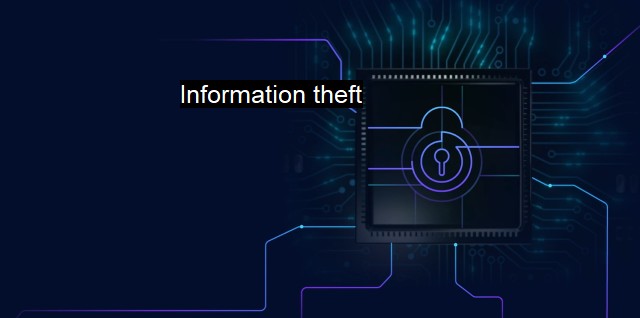What is Information theft?
Protecting Your Most Valuable Asset: Understanding Information Theft in the Digital Age
Information theft, also known as data theft, is a growing concern in today's digital-driven age. It has become exceedingly pertinent as vast amounts of data are being stored, transmitted and processed online on a daily basis. This data can range from sensitive business-related information to personal data such as personal identification information, credit card numbers, or even sensitive state secrets. understanding information theft is pivotal, for it forms the backbone of many threats and malicious activities that organizations and individuals face.Information theft is the act of obtaining unauthorized access to, taking possession of, or making unauthorized disclosure of data or information generally stored electronically. Cybercriminals are usually behind such activities and they aim to misuse this stolen information for financial gain, illegal advantage, or to harm the victim in other ways.
The methods of implementing information theft can vary widely but most of them often revolve around exploiting vulnerabilities in a system's cybersecurity practices or measures. One common technique is through malicious software or malware. The cybercriminal may use a variety of tactics to trick the user into downloading malware unwittingly. This could come in the form of phishing emails, malicious advertisements, compromising legitimate websites, or malicious attachments and links.
Once the malware gets into the user's computer, it can perform various malicious activities, including data theft. Some examples of these malware include keyloggers, which record the user's keystrokes, Trojan horses, which masquerade as legitimate software and then steal information and spyware, which monitors the user's actions without their knowledge.
Besides malware, information can also be stolen through network-based attacks. This involves exploiting network vulnerabilities to gain unauthorized access to the system. Here, the hacker can then move laterally across the network and have access to sensitive data. Such attacks can be widespread and can impact multiple systems simultaneously.
Social engineering is another tactic used often by cybercriminals. In this method, the attacker manipulates the user into providing confidential information or performing actions such as downloading a malicious file, which compromise the security posture of the organization or individual. Phishing is one such example of a social engineering attack.
In other cases, insiders present a credible risk for information theft. With authorization, access to the system, and often knowledge of security practices, disgruntled employees, contractors, or other insiders can use their position to steal information purposefully.
Consequently, robust cybersecurity and antivirus solutions are of utmost importance when it comes to combating information theft. Such solutions should ideally incorporate multiple levels of security measures, from encryption techniques and secure network setups to strong password practices and multi-factor authentication.
Antivirus software should be capable of scanning for and eliminating various types of malware. it should also provide real-time protection against new threats and regularly update databases to keep abreast of the constantly evolving threat landscape.
Proper security hygiene from users is also paramount. From being judicious about the websites they visit and the files they download, to maintaining secure password practices and not sharing sensitive information, users play a big role in mitigating the risks of information theft.
Apart from preventive measures, organizations should also have a robust incident response and disaster recovery plan. In case of a security breach, the ability to detect it quickly and minimize damage is vital.
As businesses and individuals increasingly rely on electronic data, information theft takes on greater significance. It has severe implications, resulting in financial loss, reputation damage, and regulatory ramifications. Thus, what is outlined here underscores the need for amped up cybersecurity practices and advanced antivirus mechanisms to checkmate the spiraling issue of information theft.

Information theft FAQs
What is information theft?
Information theft is the act of stealing sensitive, classified, or confidential information from a person or organization without their consent, with the intent of exploiting it for personal gain.What are the common tactics used by cybercriminals to commit information theft?
Cybercriminals use various tactics such as phishing scams, malware attacks, social engineering, hacking, and insider threats to steal personal or organizational information, often for financial gain or other malicious purposes.What can I do to prevent information theft?
To prevent information theft, you should employ security measures such as using strong passwords, updating your software and operating systems, installing reliable antivirus software, enabling two-factor authentication, backing up data regularly, and being cautious of suspicious emails or messages.What should I do if I suspect an information theft attack?
If you suspect an information theft attack, immediately disconnect your device from the internet, report it to your IT department or cybersecurity provider, change your passwords, and monitor your accounts for any suspicious activity. It is important to act quickly to minimize the damage and prevent further loss of information.| | A | | | B | | | C | | | D | | | E | | | F | | | G | | | H | | | I | | | J | | | K | | | L | | | M | |
| | N | | | O | | | P | | | Q | | | R | | | S | | | T | | | U | | | V | | | W | | | X | | | Y | | | Z | |
| | 1 | | | 2 | | | 3 | | | 4 | | | 7 | | | 8 | | |||||||